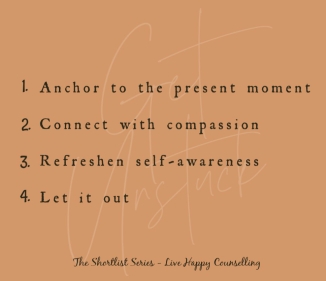The Shortlist Series: How to get Unstuck from Negative Looping Thoughts
The quote in the image above describes an idea that is so simple and yet not very easy. When we find ourselves stuck in negative looping thought-patterns, we often need a way out – a life preserver of sorts to pull us to safety. Here are four suggestions that might help you exit those negative thought cycles. And as always, if you have a strategy that works for you to healthfully exit negative looping thoughts – please add it to the comments.

1. Anchor to the Present Moment
When we find ourselves stuck in negative thinking, we may be ruminating about the past or worrying about the future. We can not change the past, and when we worry about the future, we are robbing today of its strength. Returning to the present moment may be just what you need to let your nervous system settle. Once you shift out of that worry or fear loop, your problem-solving brain can come back on-line, and the negative loop is interrupted. Not sure how to get back into the present moment? Here are some ideas:
5-4-3-2-1: Look around the room you are in, and carefully describe 5 things you can see, 4 things you can touch (actually move around and touch the items), 3 things you can hear, 2 things you can smell, and 1 thing you can taste.
Ground with Colour: Look around the room you are in and take notice of everything you can see that is blue. Go slowly, pausing to notice what the item is and its particular shade of blue. Move on from blue to notice everything that is green, then orange, and so forth until you have gone through all the colours or until the looping thoughts have settled.
Letter Association by Word: Pick a word any word, and then break it down letter by letter, coming up with as many other words that start with each letter of your chosen word. (For example: if your word is COPING, start by thinking of as many words as you can that begin with the letter C, then O words, then P, then I, then N, then G.)
(These strategies are helpful because they focus our attention in a directive manner, and thus can interrupt the negative or looping thoughts that so often accompany anxiety. And the result? You return to the present moment, and the looping thoughts are interrupted.)
2. Connect with Compassion
When we are caught up in negative looping thoughts, our heart tends to be closed off. In other words, we might be thinking about the worst-case scenario, putting ourselves down, feeling as though things will never get better, and even thinking negatively of those in our lives. To exit the negative loop, try mixing in some compassion. Dr. Kristin Neff writes, “instead of mercilessly judging and criticizing yourself for various inadequacies or shortcomings, self-compassion means you are kind and understanding when confronted with personal failings – after all, who ever said you were supposed to be perfect?”. Having self-compassion means that you honour and accept your humanness – not self-downing but just being present with loving kindness. Not sure how to connect with self-compassion? Here are some ideas:
- Talk to yourself the way you would talk kindly to a small child
- Talk to yourself the way you would talk kindly or encourage a friend or someone you care deeply for
- Try this breathing exercise for self-compassion: As you exhale, picture yourself exhaling stress, anger, worry, and frustration. As you inhale, picture yourself inhaling peace and acceptance. Continue slowing and deepening your breath, exhaling the worry, etc., and inhaling what you need.
- Look at a picture of yourself at a younger age and remember you were once a child deserving of kindness and understanding
- Look at a picture of a loved one (or look at them if you are near them) and think of 3 things you love about them
- If you have a pet, take a few minutes to pet or play with them, and soak up some impromptu pet therapy!
3. Refreshen Self-Awareness
What is beneath your upset? Are you feeling unheard, unworthy, or unaccepted? Sometimes when we are caught up in a negative cycle, we start telling ourselves things that serve to keep the cycle going. These might be called thinking traps, negative core beliefs, or psychological defences. Regardless the name you use – take a moment to deepen your self-awareness and tune in to the narrative you are telling yourself. If it is negative, take a few moments to breathe deeply and return to the present moment with loving-kindness. You might want to question that negative narrative. For example, is what you are telling yourself 100% true, 100% of the time? What would you rather be telling yourself, or what could also be true instead? The latter question will start you down the road of connecting with the positive belief you would like to build.
4. Let it out
Sometimes talking it out can help. Is there someone in your life that you could vent to? Not for advice (unless you want it) – but rather a sounding board who can witness your tidal wave and be waiting on the shore as you ride the surf out. Emotional settling can occur when we connect with a caring friend or family member and feel heard.
If no one is around, try venting by writing out what you are feeling. You can also draw, doodle, scribble, or paint. Click here if you haven’t used writing to vent and want to hear some ideas on how to get started.
Have you discovered some ideas that help to healthfully shift out of negative looping thoughts? If so, please add what works for you in the comments.


